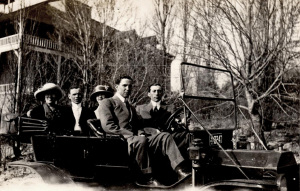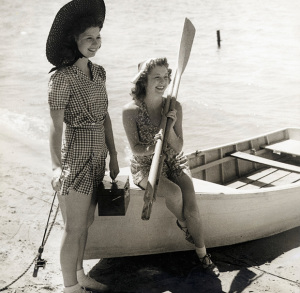Grand Haven Area History
An Overview
 Rix Robinson, who worked for the Jacob Astor’s American Fur Company as fur trapper and trader, established posts on the Grand, Kalamazoo, and Muskegon Rivers, water routes long used by Native Americans and early European explorers.
Rix Robinson, who worked for the Jacob Astor’s American Fur Company as fur trapper and trader, established posts on the Grand, Kalamazoo, and Muskegon Rivers, water routes long used by Native Americans and early European explorers.By 1827 Robinson has established 20 trading posts in lower West Michigan. He obtained rights to Grand Haven area lands in a U.S. Patent dated December 2, 1833. Less than a year later Grand Haven’s first permanent white settlers, Rev. William Montague Ferry, with family and friends, sailed down the east coast of Lake Michigan to the mouth of the Grand River. The group set ashore at Rix Robinson’s fur trading post, located near the foot of today’s Washington Street. They spent their first year in makeshift lodgings, but by the spring of 1835 they had erected permanent dwellings and the first sawmill.
A plat for the City of Grand Haven was recorded that year, and the settlement of Spring Lake, Ferrysburg, and surrounding townships soon followed. During the next sixty years, acres of once towering white pines were floated down the river and bayous to sawmills and then shipped to lucrative markets throughout the Midwest.
 Within sixty years of Rev. Ferry’s arrival, the lumbering industry had come to an end. Local businessmen formed a Board of Trade that enticed a variety of manufacturing firms to relocate to Grand Haven and take advantage of Lake Michigan to transport their goods. About the same time, an increasingly affluent middle class sought relaxation and recreation along the shores of Lake Michigan, Spring Lake, and the Grand River. Arrival of the railroad in 1858 spurred further development of the manufacturing and resort industries. Lake Michigan storms took their toll on boats and crews. A group of volunteer lifesavers banded together in 1871 to save the lives of those whose vessels were imperiled. By the end of the decade, an Act of Congress established the United States Life Saving Service. In 1915 Congress founded the Coast Guard, who took over the mission of the Life Saving Service. Nine years later local residents proposed a community picnic to honor the Coast Guard. Rain delayed that inaugural picnic for a year, but by the mid-1930s the celebration had grown into the annual Coast Guard Festival, as eagerly anticipated event.
Within sixty years of Rev. Ferry’s arrival, the lumbering industry had come to an end. Local businessmen formed a Board of Trade that enticed a variety of manufacturing firms to relocate to Grand Haven and take advantage of Lake Michigan to transport their goods. About the same time, an increasingly affluent middle class sought relaxation and recreation along the shores of Lake Michigan, Spring Lake, and the Grand River. Arrival of the railroad in 1858 spurred further development of the manufacturing and resort industries. Lake Michigan storms took their toll on boats and crews. A group of volunteer lifesavers banded together in 1871 to save the lives of those whose vessels were imperiled. By the end of the decade, an Act of Congress established the United States Life Saving Service. In 1915 Congress founded the Coast Guard, who took over the mission of the Life Saving Service. Nine years later local residents proposed a community picnic to honor the Coast Guard. Rain delayed that inaugural picnic for a year, but by the mid-1930s the celebration had grown into the annual Coast Guard Festival, as eagerly anticipated event.Of special interest to local citizens was the arrival of the Coast Guard Cutter Escanaba in December, 1932. The community was saddened when the vessel was sunk during World War II in the North Atlantic. Only two of the 103 crewmen survived. Escanaba Park was established as a memorial to those sailors aboard the Escanaba. Grand Haven was declared “Coast Guard City USA” by Act of Congress in 1998.
by Wallace K. Ewing
Want to learn more Grand Haven area history? Check out these pages:






